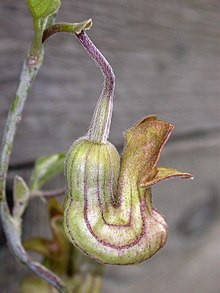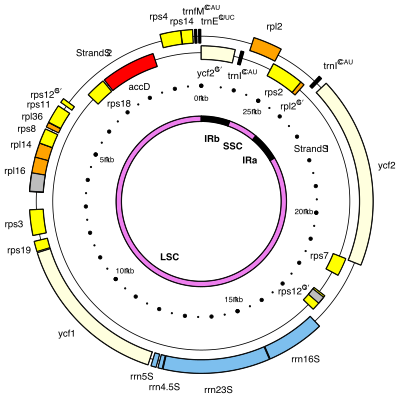Aristolochiaceae
| Aristolochiaceae Temporal range:
| |
|---|---|

| |
| California pipevine (Aristolochia californica) | |
| Scientific classification | |
| Kingdom: | Plantae |
| Clade: | Tracheophytes |
| Clade: | Angiosperms |
| Clade: | Magnoliids |
| Order: | Piperales |
| Family: | Aristolochiaceae Juss. |
| Subfamilies | |
| |
| Synonyms | |
| |
The Aristolochiaceae (English: /əˌrɪstəˈloʊkiəsii/) are a family, the birthwort family, of flowering plants with seven genera and about 400 known species belonging to the order Piperales. The type genus is Aristolochia L.
Description
They are mostly
Classification
Aristolochiaceae are
Some newer classification schemes, such as the update of the Angiosperm Phylogeny Group, place the family Aristolochiaceae in the order Piperales, but it is still quite common, though superseded, for the Aristolochiaceae to be assigned, sometimes with some other families, their own order (Aristolochiales).
Phylogeny
Eight genera are accepted –
Four assemblages can be distinguished in the genus-level cladogram of Aristolochiaceae:
- Aristolochia is closely related to Thottea.
- Hydnora is closely related to Prosopanche.
- Lactoris occupies an isolated position.
- Asarum is closely related to Saruma, and both genera display a deep-branching position in the family.
| Genus-level cladogram of the Aristolochiaceae. | |||||||||||||||||||||||||||||||||
| |||||||||||||||||||||||||||||||||
| The phylogeny is based on the Angiosperm Phylogeny Website.[7][8] |
Phytochemistry
Many members of Aristolochia and some of Asarum contain the toxin aristolochic acid, which discourages herbivores and is known to be carcinogenic in rats. Aristolochia species are carcinogenic to humans.
Genomics

The complete
Ecology
Fossil record
The earliest records of the family are the
References
- ^ "Piperales". www.mobot.org. Retrieved 2023-06-18.
- ^ ISSN 1058-5893.
- .
- ^ Aristolochiaceae Juss. Plants of the World Online. Retrieved 18 January 2024.
- ^ "GRIN Genera of Aristolochiaceae subfam. Asaroideae". Germplasm Resources Information Network. United States Department of Agriculture. Retrieved 2011-01-09.
- ^ "GRIN Genera of Aristolochiaceae subfam. Aristolochioideae". Germplasm Resources Information Network. United States Department of Agriculture. Retrieved 2011-01-09.
- ^ Stevens, P.F. (2001). "ARISTOLOCHIACEAE Jussieu". Angiosperm Phylogeny Website. 13. Retrieved 30 December 2017.
- ^ "Family: Aristolochiaceae Juss., nom. cons". Germplasm Resources Information Network. United States Department of Agriculture. 2007-04-12. Retrieved 2011-01-09.
- PMID 26739167.
- ^ List of sequenced plastomes: Flowering plants.
- ^ Evolution and Diversification of Land Plants by Kunio Iwatsuki and Peter H. Raven, Springer Science & Business Media, 6. des. 2012
- ^ The first fossil Aristolochia (Aristolochiaceae, Piperales) leaves from Austria by Barbara Meller, Article number: 17.2.21A, https://doi.org/10.26879/420, Palaeontological Association, May 2014
